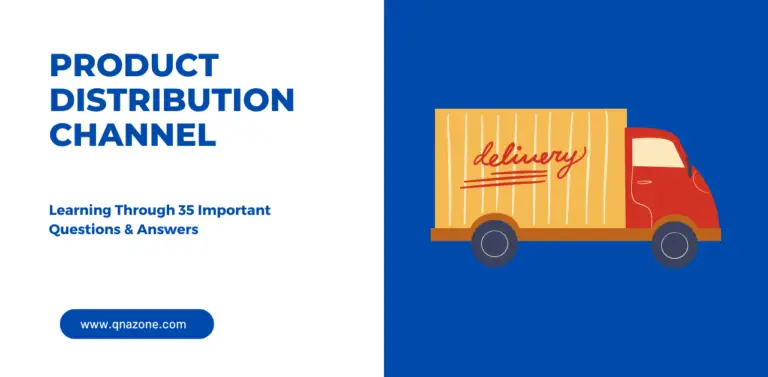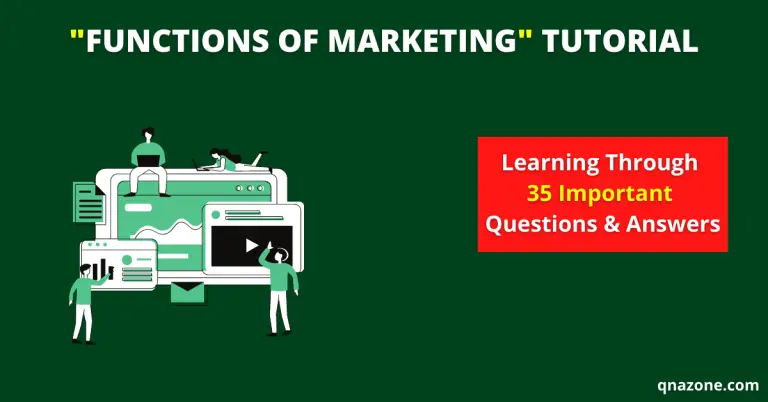25 Important Pricing Products Questions and Answers [With PDF]
The 7th chapter of our marketing learning course is “Pricing Products.” In this article, we’ll learn the 25 most important pricing product questions and their answers.
It will assist you in quickly learning how to price products, what factors influence product pricing, what factors should be considered when pricing products, and much more.
By reading this post, you may quickly prepare for marketing courses and for any competitive tests such as school and college exams, vivas, job interviews, and so on.
So let’s get started.
Pricing Products Questions and Answers
The 25 most important pricing products questions and answers are as follows:
Question 01: What is the price?
Answer: A price is the sum of money paid in exchange for a specific quantity of goods or services.
Question 02: What is the concept of the price?
Answer: The following is the price concept:
- “Price” refers to the monetary value of a product or service.
- The product’s ownership is transferred as a result of this.
- A price is a unit of measurement for goods or services exchanged.
- It is a metric for determining how useful a product or service is.
- The price refers to the cost of exchanging goods.
Question 03: What is the significance of price in marketing?
Answer: The significance of price in marketing is as follows:
- Assist in achieving objectives.
- It is a symbol of status.
- It meets the needs of the customers.
- Make a perfectly competitive market.
- Create a positive image.
- Maintain price stability.
- Remove the threat of an economic downturn.
- Increase the amount of foreign competition.
Question 04: What is the pricing?
Answer: Pricing is the process of determining the price of a product or service.
Question 05: What are the objectives of pricing?
Answer: The following are the most important pricing objectives:
General Objectives:
- Survival
- Leadership in product quality
Profit maximizing objectives:
- Profit maximization
- Getting a Return on Investment
- Ensuring cash flows
Sales-oriented objectives:
- In order to boost sales,
- To gain a larger market share,
Unchanged objectives:
- To compete with others.
- Maintaining price stability
- To promote the company’s positive image.
Question 06: What are the important factors to consider when determining pricing?
Answer: When it comes to pricing, the following are the most important factors to consider:
Internal factors:
- Marketing goals
- Strategy for the marketing mix
- Costs
- Policy on pricing.
External factors:
- Market and consumer demand.
- competitors’ costs, prices, and offers
- The policy of the government
- Social accountability
- The country’s financial situation
Question 07: What impact does the marketing mix have on pricing decisions?
Answer: A company’s price is one of the four marketing mix tools it employs to achieve its marketing objectives.
Price considerations must be synchronized and integrated with product design, distribution, and promotion decisions to establish a uniform and effective marketing program.
Pricing decisions are usually influenced by decisions made for other marketing-mix variables.
For example, producers who rely on a large number of middlemen to support and promote their products may need to include higher middleman margins in their pricing.
Question 08: What impact do the costs have on pricing decisions?
Answer: Costs determine the lowest price at which a firm can no longer sell its goods. The corporation wants to charge a price that covers all of its costs of manufacturing, distributing, and selling the product while also providing a satisfactory return on investment.
The costs of a corporation may have a significant impact on its pricing approach. Companies with fewer costs can charge lower prices, resulting in higher sales and profits.
Question 09: What impact do the market and demand have on pricing?
Answer: The lower price limit is set by cost considerations, while the upper price limit is set by market demand.
Buyers, both retail and industrial, assess the cost of a product or service against the benefits of possessing it.
As a result, the marketer must understand the relationship between price and demand for his or her product before determining prices.
Question 10: What impact do the environmental elements have on pricing?
Answer: When determining prices, a company must also consider other aspects of its external environment.
The economic climate of a country can have a significant impact on a company’s pricing tactics. Economic factors such as booms and busts, inflation, and interest rates have an impact on pricing decisions since they affect both production costs and customer perceptions of price and value.
The corporation must also examine how its price may affect other parties in its environment. The company should set rates that allow middlemen to make an acceptable profit, encourage their support, and assist them in effectively selling the goods.
The government may also influence pricing decisions. Finally, societal issues must also be addressed.
Short-term sales, market share, and profit goals may have to be subjugated to broader societal interests when determining prices.
Question 11: What are the steps involved in determining a price?
Answer: The following are the steps of price setting:
- Choosing a pricing objective.
- Evaluation of the target market’s price perception and purchasing power.
- Demand estimation.
- Cost-benefit analysis.
- An analysis of the costs, prices, and offers of competitors.
- Choosing a pricing method.
- Determines a specific price.
Question 12: What is the pricing method?
Answer: The pricing method is a method for establishing prices on a regular basis that follows a systematic procedure.
Question 13: What methods are used to determine pricing?
Answer: The following are the methods used to determine pricing:
- Cost-based pricing
- Value-based pricing
- Competition based pricing
- Demand oriented pricing
- Other pricing methods.
Question 14: What is the cost-plus pricing method?
Answer: Cost-plus pricing is the most basic of all the pricing methods, and it involves adding a standard markup to the product’s cost.
Question 15: How do you determine the price in the cost-plus pricing method?
Answer: To demonstrate markup pricing, consider the following costs and expected sales for a soap manufacturer:
Variable cost $6
Fixed cost $200,000
Expected unit sales 100,000 pcs
After that, the producer’s cost per soap is calculated as follows:
Unit Cost = Variable Cost + Fixed Cost/Unit Sales
= $6+ ($200,000/100,000)
= $7
Assume the producer wants a 30% profit margin on sales. The producer’s markup price is calculated as follows:
Markup Price = Unit cost/(1-Desired turn-on sales)
= $7/(1-.30)
=$10
The producer would charge $10 per soap to distributors and make a $3 profit per unit.
Question 16: What is break-even pricing?
Answer: Break-even pricing is another cost-focused pricing strategy. “Target profit pricing” is a variation of this strategy.
Break-even pricing is when a company tries to figure out what price it needs to break even or make the profit it wants.
Question 17: What is competition-based pricing?
Answer: The level of market competition is also a significant factor in determining product pricing. In a competitive market, a company must first assess the price and offer of its competitors before deciding on a price for its own product.
In competition-based pricing, companies use going-rate and sealed bid pricing techniques.
Question 18: What is going-rate pricing?
Answer: Going-rate pricing is when a company bases its price primarily on the prices of its competitors. The importance of the firm’s own costs or demands is downplayed.
The company may set prices that are similar to those of its major competitors. The concept of going-rate pricing is very popular.
Question 19: What is sealed-bid pricing?
Answer: In sealed-bid pricing, a company’s price is determined by the prices of its competitors rather than its own costs or demand.
The company is serious about landing a contract that requires it to offer lower prices than competitors.
Still, the firm cannot set its price below a certain level because pricing below that level will harm the company. In contrast, as a firm’s price rises, the likelihood of obtaining a contract decreases.
When a company wants to win a contract or a job, it uses this pricing method.
Question 20: What is value-based pricing?
Answer: Many businesses are beginning to accept a product’s perceived value as a basis for pricing. Value-based pricing, rather than using the seller’s cost, bases pricing on the buyers’ perceptions of value.
According to value-based pricing, a marketer cannot design a product and marketing program before deciding on a price.
Prior to forming the marketing program, price is considered alongside the other elements of the marketing mix.
Question 21: What are the price-adjustment strategies?
Answer: The strategies for price adjustment are as follows:
- Price discount and allowance.
- Segmented pricing
- Psychological pricing
- Promotional pricing
- Geographical pricing
- Dynamic pricing
Question 22: What are the various kinds of price discounts and allowances?
Answer: The following are the various kinds of price discounts and allowances:
- Cash discounts
- Trade discounts
- Quantity discounts
- Seasonal discounts
- Allowances
Question 23: What is psychological pricing?
Answer: A price can have psychological connotations, such as a high price implying high quality, an odd price implying a lower price range, or it can imply a discount or bargain.
For example, a product priced at $500 per unit may contain $400 worth of product, but consumers will be willing to pay $500 for the product because it communicates a $500 image.
Higher prices may be charged for ego-sensitive goods.
Another example would be a product that costs $499 rather than $500. Customers may perceive this as a $400 price rather than a $500 price.
Question 24: What are the different types of promotional pricing techniques?
Answer: The different types of promotional pricing techniques are as follows:
- Loss-leader pricing
- Special event pricing.
- Low-interest financing
- Warranties and service contracts.
- Cash rebates
- Longer payment terms
Question 25: What are the different types of segmented pricing techniques?
Answer: The different types of segmented pricing techniques are as follows:
- Customer segmented pricing
- Product form pricing
- Location-based pricing
- Time-based pricing
I hope that by the end of this post, you have a good understanding of the “pricing products” chapter.
You will gain a better understanding of the “pricing products” chapter if you read these 25 important pricing products questions and answers on a regular basis.
You may also read:
- 30 Important Introduction to Marketing Questions & Answers [With PDF]
- 25 Important Marketing Environment Questions & Answers [With PDF]
- 35 Important Marketing Functions Questions & Answers [With PDF]
- 25 Important Marketing Segmentation Questions & Answers [With PDF]
- 25 Important Marketing Mix Questions and Answers [With PDF]
- 35 Important Product Questions and Answers [With PDF]
- 35 Important Product Distribution Channel Questions and Answers [With PDF]






